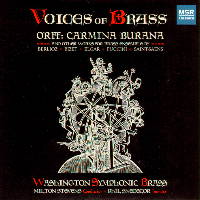
A Robust Heart
Washington
Symphonic Brass -
heard by
HOWARD SMITH'... a programme deserving of sustained applause and huge admiration.'
|

|
Though this substantially male seventeen-member brass and percussion ensemble blow up a 'perfect storm' throughout the main 40+ minute item, Orff's rhythm-driven Carmina Burana; this score's medieval lyrics are central to the work and with Washington's brass solo substitutes, while the work retains a robust heart, it is entirely without soul.
Listen -- Orff: O Fortuna (Carmina Burana)
(track 1, 0:00-0:46) © 2006 Washington Symphonic Brass
The sacred and profane thirteenth century manuscripts (119 leaves) were discovered (1803) in the Bavarian monastery of Benediktbeuern, some thirty miles south of Munich Bayerische Staatsbibliothek where they're housed today. Carmina Burana is uniquely reliant on these intriguing texts whereas the excerpts (later) from Carmen, La bohème and Turandot seem somewhat less misplaced without their vocals.
Having said that, one should acknowledge the passing of the man who steered Washington Symphonic Brass to its prominence within the Washington/Baltimore conurbation; co-founder, music director and conductor Milton Stevens (1942-2007), the presiding light for this resounding programme.
Dr Stevens, principal trombonist of the National Symphony Orchestra since 1978, earned degrees from the Oberlin Conservatory of Music, the University of Illinois and Boston University. He pursued additional studies at Tanglewood and at the Mozarteum in Salzburg, Austria. Conducting studies were with Gerhardt Wimberger in Salzburg and with Bernard Goodman and Walter Eisenberg in the USA.
The Brass' board of directors includes such luminaries as Leonard Slatkin and Gerard Schwarz. Indeed, in October 2007, Slatkin led the WSB at the Kennedy Centre's Terrace Theatre in a outstanding sampling of sonority gradations possible with such an ensemble. Its instrumental combinations, without strings and woodwinds, reimagined scores by Mussorgsky and Respighi.
At that event Slatkin reportedly quipped: '... you know, I don't miss the other guys.'
The ensemble opened their programme with a memorial tribute to Stevens; a tranquil arrangement of Brahms' Let Nothing Ever Grieve Thee. Critics commented on 'solemnity underlined by a glistening, molten legato.'
Nonetheless, the American sound is oceans removed from strains such as those of Grimethorpe Colliery or Foden Motor Works Bands. The aching plangency of British works bands has an indefinable capacity to coalesce communities in times of misfortune, unrest or disaster.
By contrast American brass ensembles have their own outgoing razzmatazz brilliance and sufficient technique to bring audiences to their feet. They embody the spirit of New World entertainment.
Listen -- Berlioz: Marche au supplice (Symphonie Fantastique)
(track 17, 3:36-4:42) © 2006 Washington Symphonic Brass
Even Berlioz's March to the Scaffold (Movement 4 of Symphonie Fantastique) is rousing in Snedecor's arrangement, and while some listeners may miss the gutsy upwelling of strings at its climax, WSB play the composer's eerie, leering, death march to the hilt.
Whether Che gelida manina, the first item in a Puccini bracket, is followed by Nessun dorma (1926) as a tacit tribute to Luciano Pavarotti is uncertain, but the great Modena-born tenor must be credited with bringing the item to global attention. Here, despite Martin Hackleman's unblemished 'Rodolfo' (La bohème, 1896) and trombonist Charles Casey's fine 'Pavarotti', WSB miss the thrill of great solo voices. All the same; I don't doubt these will be a great brass favourites.
Steven's inclusion of Elgar's Nimrod, the eloquent ninth portrait from Enigma Variations (1898/99), and tribute to Sir Edward's editor August Jaeger, is about as English as this CD gets, and WSB give the excerpt all the broad elegaic quality it requires.
Best of all, however, is the concluding item; a stunning account of the finale from Saint-Saëns' Symphony No 3 'Organ' (1886). Here and in the preceding Nimrod, organist William Neil lends his weight to the bouyant brass.
Listen -- Saint-Saëns: Finale (Symphony No 3)
(track 22, 6:41-7:47) © 2006 Washington Symphonic Brass
It's a rousing finish to a programme deserving of sustained applause and huge admiration.
Copyright © 16 November 2009
Howard Smith,
Rarotonga, Cook Islands
 CD INFORMATION: VOICES OF BRASS
CD INFORMATION: VOICES OF BRASS
| 
